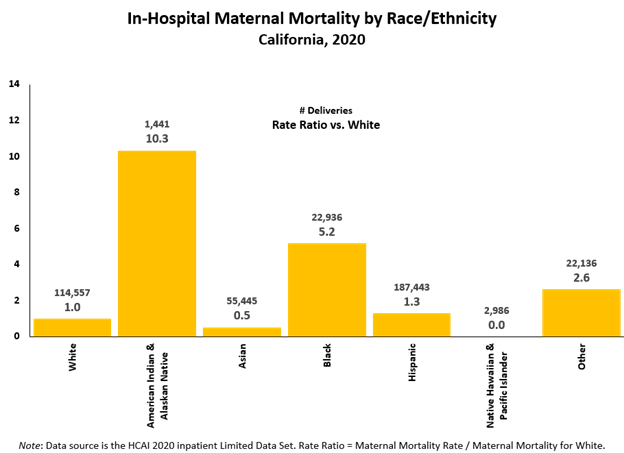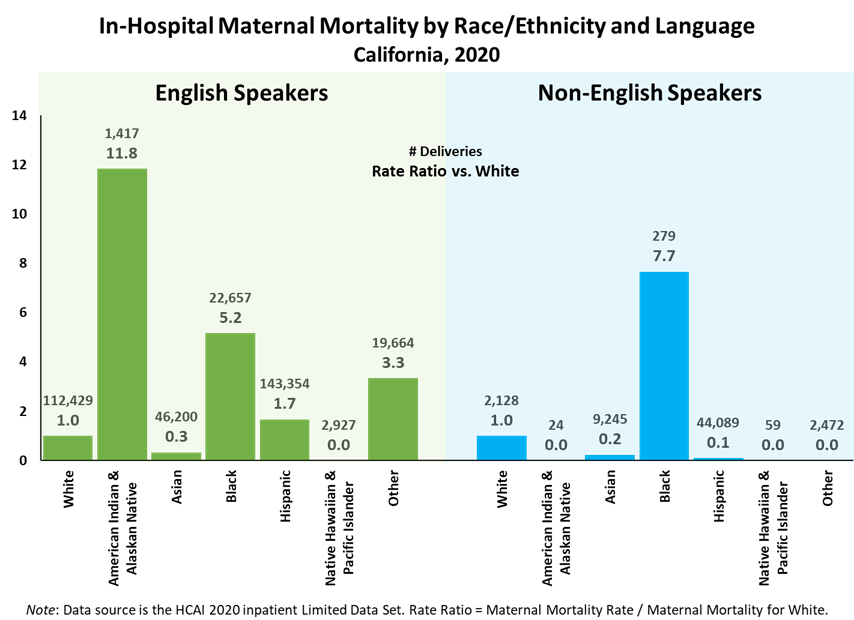Dreams of a beautiful nursery, the trials and tribulations of being a new mother, and the bond with a new child — for most new U.S. moms, the excitement of parenthood is anything but a pipe dream.
But sadly, not all new mothers will get to live through such an experience. Though maternal mortality rates have been improving in California, there are still issues with prenatal care that tragically cause new mothers to pass away. In the U.S., maternal mortality is a matter that has been of increasing concern. Factors ranging from poor midwife care to inferior postpartum guidance for new moms could be reasons we are seeing problems with maternal mortality.
For the first half of our analysis, we studied racial/ethnic differences amongst in-hospital delivery-related deaths. Though every death should still be regarded as a cause for concern, in absolute terms a very small number of maternal deaths occur in California hospitals. Of over 400,000 deliveries in California hospitals in 2020, 39 maternal deaths occurred. Though differences in maternal deaths across race/ethnicity are important from an equity perspective, the actual numbers of maternal deaths across groups were quite small.
Differences in Maternal Mortality by Race/Ethnicity
Racial disparities are one of the biggest issues regarding maternal mortality not only in California but in the U.S. Though the color of a person’s skin — or their ethnicity — should not affect their care, the sad reality is that there are differences amongst African Americans, Asians, Hispanics, and whites when it comes to safety during childbirth and delivery. The analysis was complicated by limited population sizes amongst the different racial groups. The white and Hispanic population of birthing mothers reached over 100,000, but the number of African American deliveries was only around 20,000. Therefore, even if there were only several more deceased mothers in one racial category versus another, differences in the population of birthing mothers made calculations of death rates per racial group bigger.

Analyzing these numbers, we compared them to our baseline race: whites. Native American mothers were 10.3 times as likely to perish giving birth compared to whites. African American mothers were 5.2 times as likely to die giving birth compared to whites. Hispanic mothers were 1.3 times as likely to die compared to whites. However, Asian mothers were less likely to die, with a rate ratio of 0.5 compared to white mothers.
Differences in Maternal Mortality by Race/Ethnicity and Language
The second part of our analysis focused on differences in maternal mortality as a function of both race/ethnicity and the primary language of the mother. Based on the mother’s recorded preferred language during the delivery, we categorized the mothers as English versus non-English speaking, which is a rough proxy for being a recent immigrant for some of the race/ethnicity groups.

Analyzing the race/ethnicity maternal mortality rates stratified by language, an interesting pattern emerged. Whites were more likely to die if they were recent immigrants (Rate Ratio (RR) = 7.8 vs. English-speaking whites). Compared to non-English speaking whites, non-English Hispanic mothers were much less likely to die (RR = 0.1). For African American mothers, immigration status did not make much of a difference — their rates of maternal mortality were elevated regardless of whether they spoke English.
Though the first part of our analysis matched previous findings that showed maternal mortality rates are unequal based on race/ethnicity, the second part revealed fascinating findings regarding how immigration status interacts with race/ethnicity regarding maternal mortality. Adding language as a factor to assess maternal mortality revealed differences amongst racial groups that were not initially expected. The findings reflect that perhaps there may be issues with translation in prenatal care among some European white immigrants, whereas Hispanic immigrants are more likely to be assimilated into the culture of quality prenatal care. Of course, we would hope in future analyses to see reductions across all groups in maternal deaths and reductions in disparities by race/ethnicity and immigration status — to see numbers that reflect a wonderful California and marvelous America in which no new mother dies.
